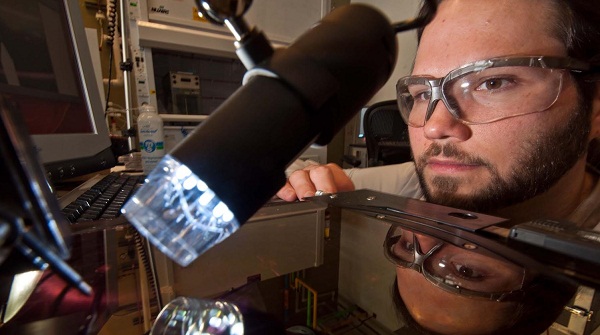It’s only 5 inches by 5 inches, but it might signal a breakthrough that opens the door—or, better put, window—to a better way to turn glass surfaces into power producers. The development comes from New Energy Technologies, working with scientists from the National Renewable Energy Laboratory (NREL) on the company’s trademarked SolarWindow technology for generating electricity on see-through glass.
The company said it had fabricated the largest-area organic photovoltaic (OPV) module ever produced at the NREL, creating a working 170-square-centimeter working module. That’s more than 14 times larger than previous OPV devices made at NREL.

Solar windows are hardly widespread, but we have seen them popping up in use more and more. The dairy cooperative Organic Valley recently installed solar windows at its headquarters in La Farge, Wis. The facility’s 20 solar windows, manufactured by Pythagoras Solar, are designed to simultaneously optimize daylighting to improve the building’s energy efficiency, while producing solar power.
Pythagoras turns windows into power producers by embedding horizontal rows of silicon cells between dual panes of glass. New Energy Technologies is taking a different approach, using electricity-generating polymers that can be applied to a surface to create an organic photovoltaic cell.
A big advantage to its approach, the company claims, is found in a more economical production process, one that is “compatible with roll-to-roll (R2R) high-speed and high-volume fabrication methods, potentially providing for very-large scale manufacturing.” The company says that compared to manufacturing of first-generation solar products, its low temperature and ambient pressure R2R manufacturing process promises “low labor costs; decreased capital equipment expenditure; reduced cost of energy required for production; and improved environmental and occupational control.”
While New Energy Technologies has put out a steady stream of press releases—late last year we had the annual output at 23—this time around it has the respected NREL on board to give this news a little more oomph. “The fabrication of a large-area see-through solar module of these dimensions is an important step in New Energy’s SolarWindow ongoing development,” David S. Ginley, an NREL research fellow, said in the statement put out by New Energy Technologies. “We believe that building-integrated applications provide a promising avenue for OPV deployment and we are continuing to work with New Energy Technologies to further address scale-up, a key milestone toward developing a deployable technology.”